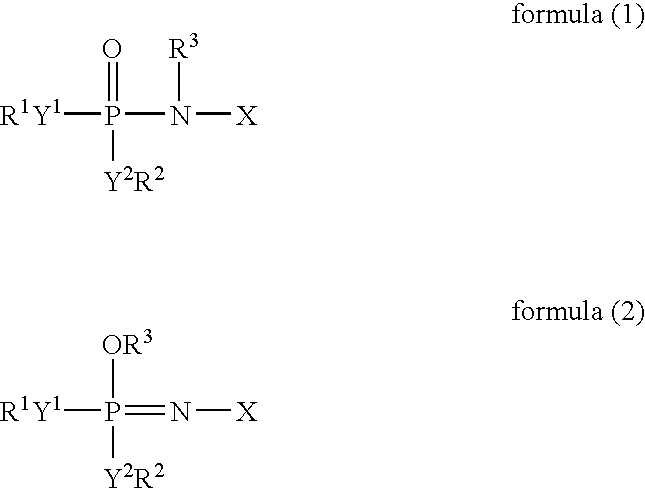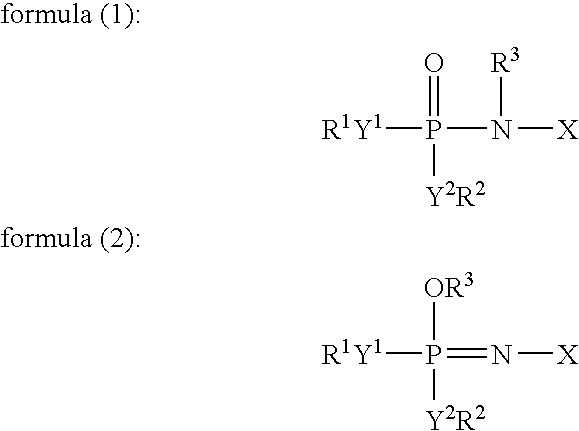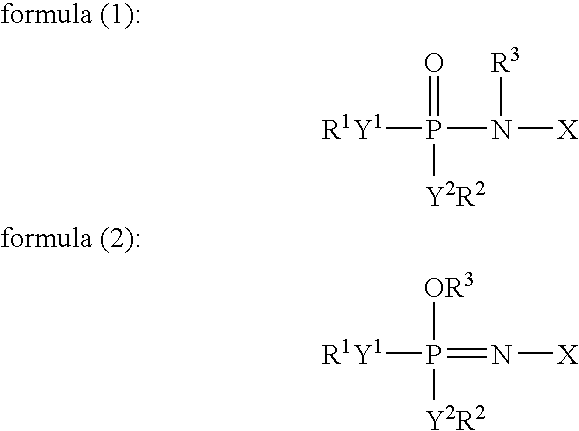Additive for nonaqueous-electrolyte secondary battery
a technology of nonaqueous electrolyte and secondary cells, which is applied in the field of additives for nonaqueous electrolyte secondary cells, can solve the problems of high danger of cell moltenness, cell explosion and ignitement, and negative electrode materials and water reacting to the environment, and achieves excellent self-extinguishability or flame retardancy, low temperature characteristics, and low interface resistance.
- Summary
- Abstract
- Description
- Claims
- Application Information
AI Technical Summary
Benefits of technology
Problems solved by technology
Method used
Image
Examples
example 1
Preparation of a Non-aqueous Electrolytes for Non-aqueous Electrolyte Secondary Cell
[0172]To 49 ml of a mixed solvent of diethyl carbonate and ethylene carbonate (mixture ratio (i.e., volume ratio): diethyl carbonate / ethylene carbonate=1 / 1) (aprotic organic solvent) (2 vol %) were added 1 ml (2 vol %) of an additive for a non-aqueous electrolyte secondary cell comprising: 50 vol % of a tautomer (a compound represented by formula (1) in which X is a substituent (A) represented by formula (3), R1 to R5 individually represent an ethyl group, and Y1 to Y2, Y4 to Y5, and Z represent oxygen elements); and 50 vol % of a phosphazene derivative represented by formula (2) (a compound represented by formula (2) in which X is a structure of a substituent (A) represented by formula (3), R1 to R5 individually represent an ethyl group, and Y1 to Y2, Y4 to Y5, and Z represent oxygen elements). Further, LiPF6 (supporting salt) was dissolved at concentration of 0.75 mol / kg in this mixture, whereby a ...
example 2
[0185]Except that the amount of the mixed solvent of diethyl carbonate and ethylene carbonate (mixture ratio (i.e., volume ratio): diethyl carbonate / ethylene carbonate=1 / 1) (aprotic organic solvent) was changed to 48 ml, and 1 ml of the additive for a non-aqueous electrolyte secondary cell was replaced by 2 ml (4 vol %) of an additive for a non-aqueous electrolyte secondary cell comprising: 10 vol % of the tautomer (a compound represented by formula (1) in which X is a substituent (A) represented by formula (3), R1 to R5 individually represent an ethyl group, and Y1 to Y2, Y4 to Y5, and Z represent oxygen elements); and 90 vol % of a phosphazene derivative represented by formula (2) (a compound represented by formula (2) in which X is a structure of a substituent (A) represented by formula (3), R1 to R5 individually represent an ethyl group, and Y1 to Y2, Y4 to Y5, and Z represent oxygen elements) in the “Preparation of a non-aqueous electrolyte for a non-aqueous electrolyte seconda...
example 3
[0186]Except that the amount of the mixed solvent of diethyl carbonate and ethylene carbonate was changed to 35 ml, and that of the additive for the non-aqueous electrolyte secondary cell was changed to 15 ml (30 vol %) thereof, and the supporting salt was replaced by LiBF4 in the “Preparation of a non-aqueous electrolytes for non-aqueous electrolyte secondary cell” in Example 1, a non-aqueous electrolyte (viscosity at 25° C.: 5.2 mPa·s (5.2 cP)) was prepared in the same manner as that in Example 1, whereby self-extinguishability or flame retardancy and deterioration resistance were evaluated. Further, a non-aqueous electrolyte secondary cell was made in the same manner as that in Example 1, and initial cell properties (such as voltage and internal resistance), charging / discharging cycle performance, low-temperature characteristics were respectively measured and evaluated. The results are shown in table 1.
PUM
| Property | Measurement | Unit |
|---|---|---|
| vol % | aaaaa | aaaaa |
| vol % | aaaaa | aaaaa |
| melting point | aaaaa | aaaaa |
Abstract
Description
Claims
Application Information
 Login to View More
Login to View More - R&D
- Intellectual Property
- Life Sciences
- Materials
- Tech Scout
- Unparalleled Data Quality
- Higher Quality Content
- 60% Fewer Hallucinations
Browse by: Latest US Patents, China's latest patents, Technical Efficacy Thesaurus, Application Domain, Technology Topic, Popular Technical Reports.
© 2025 PatSnap. All rights reserved.Legal|Privacy policy|Modern Slavery Act Transparency Statement|Sitemap|About US| Contact US: help@patsnap.com



